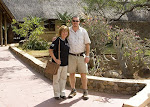
Kolo is our private guide for the day. Since I own a travel agency, I want to see the attractions that I would recommend to a client who only has one day in Johannesburg. Based on Kolo's recommendation, we totally change our itinerary to visit the downtown and suburbs of Johannesburg as well as the Apartheid Museum. Kolo points out Nelson Mandela’s home which is located in an exclusive area not far from where we are staying. We drive through the downtown area which is filled with stores and buildings, many which are vacant. The downtown streets were filled with black South Africans, but we didn't seea a single white person. Kolo explained that 20 years ago this area was predominantly white middle class, but they have all moved to the suburbs. Buildings have been boarded up to prevent the homeless from moving in. With unemployment levels at 35% (it used to be 50%), this seems to be where the unemployed black South African’s pass time.
From here we head for Soweta, where the Apartheid movement started. We passed one neighborhood with very nice homes, each one different from the other. Kolo pointed out one house where a businessman and his wife lived and then another house on the opposite side of the street about 4 houses down where the same businessman and Wife #2 lives. It seems strange that in a country with so much poverty, polygamy would be legal. I guess polygamy is just for the wealthy. Just a few blocks away from this affluent neighborhood were thousands of tin shacks known as shantytowns. The shacks had dirt floors, no toilets, and water is carried from a central spigot. However, the shack we visited was clean and the people seemed proud. There were clean clothes swaying on clothes lines, corn drying, and schools and daycares were filled with children playing. Bags of potatoes and cereal hang from the rafters of a covered shack where people can buy one diaper, one cigarette, or food for their next meal, whatever they have money for.
Kolo told us that he paid 11 cows for his wife’s hand in marriage. I thought he was teasing me, but he assured me that Lobola (the price paid for the right to marry a woman) is still practiced in South Africa. We passed a small herd of goats, and he told me that goats were still sacrificed for important occasions. There still seems to be a lot of tradition and superstition in Africa.
Our next stop is the Hector Peterson Museum. The Dutch descendants who immigrated to South Africa spoke Afrikaan. Black South African’s spoke English. The Dutch were in control of the country, and they changed the language used to teach in schools from English to Afrikaan. Afrikaan was seen as the language of the oppressor. In protest, school children in Soweta staged a demonstration, and resulted, killing young Hector Peterson. He was only 12.

I’d like to know more about the history of South Africa, so I’m looking forward to the Apartheid museum. First we stopped at a local café for lunch.
Afternoon - We spent several hours at the Apartheid museum. It seems that the black people of South Africa have come full circle. They fought so hard for their freedom, Nelson Mandela came into power and brought great progress to South Africa, and yet several years later, the government seems to be corrupted by greed and discrimination. So sad. It is a strange feeling to be the only caucasians in a museum that tells the story of black oppression. Dennis and I feel that this day is the perfect ending to our vacation as we have now experienced the history of South Africa along with the beautiful scenery and nature.
Back at the hotel, we decide to visit the same Italian restaurant from the night before – this time for pasta and sangria. Tomorrow afternoon we head home.



No comments:
Post a Comment